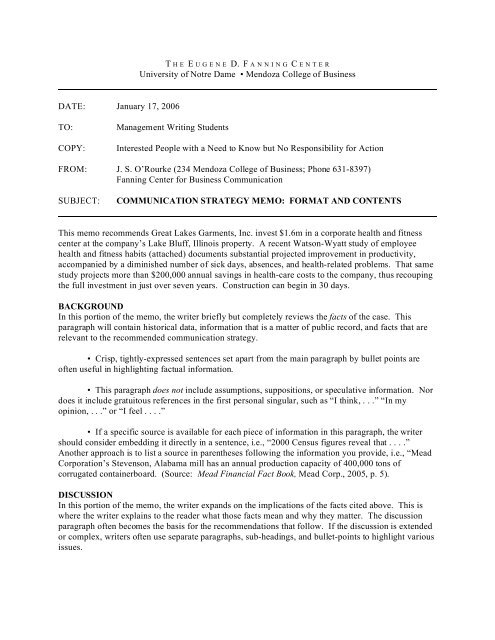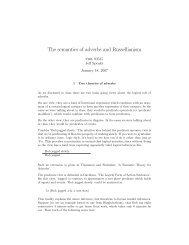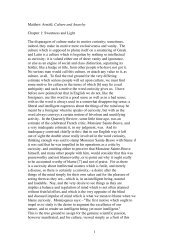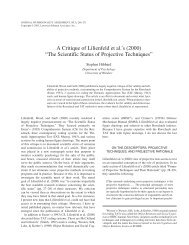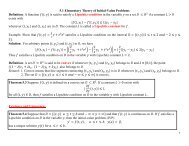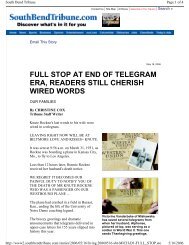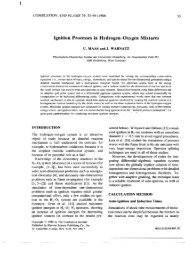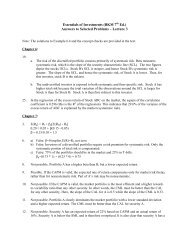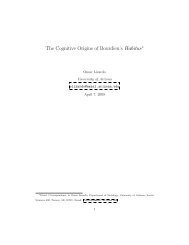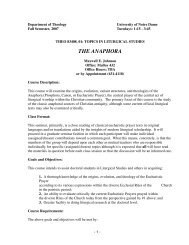Memo format - University of Notre Dame
Memo format - University of Notre Dame
Memo format - University of Notre Dame
You also want an ePaper? Increase the reach of your titles
YUMPU automatically turns print PDFs into web optimized ePapers that Google loves.
DATE: January 17, 2006<br />
T H E E U G E N E D. F A N N I N G C E N T E R<br />
<strong>University</strong> <strong>of</strong> <strong>Notre</strong> <strong>Dame</strong> • Mendoza College <strong>of</strong> Business<br />
TO: Management Writing Students<br />
COPY: Interested People with a Need to Know but No Responsibility for Action<br />
FROM: J. S. O’Rourke (234 Mendoza College <strong>of</strong> Business; Phone 631-8397)<br />
Fanning Center for Business Communication<br />
SUBJECT: COMMUNICATION STRATEGY MEMO: FORMAT AND CONTENTS<br />
This memo recommends Great Lakes Garments, Inc. invest $1.6m in a corporate health and fitness<br />
center at the company’s Lake Bluff, Illinois property. A recent Watson-Wyatt study <strong>of</strong> employee<br />
health and fitness habits (attached) documents substantial projected improvement in productivity,<br />
accompanied by a diminished number <strong>of</strong> sick days, absences, and health-related problems. That same<br />
study projects more than $200,000 annual savings in health-care costs to the company, thus recouping<br />
the full investment in just over seven years. Construction can begin in 30 days.<br />
BACKGROUND<br />
In this portion <strong>of</strong> the memo, the writer briefly but completely reviews the facts <strong>of</strong> the case. This<br />
paragraph will contain historical data, in<strong>format</strong>ion that is a matter <strong>of</strong> public record, and facts that are<br />
relevant to the recommended communication strategy.<br />
• Crisp, tightly-expressed sentences set apart from the main paragraph by bullet points are<br />
<strong>of</strong>ten useful in highlighting factual in<strong>format</strong>ion.<br />
• This paragraph does not include assumptions, suppositions, or speculative in<strong>format</strong>ion. Nor<br />
does it include gratuitous references in the first personal singular, such as “I think, . . .” “In my<br />
opinion, . . .” or “I feel . . . .”<br />
• If a specific source is available for each piece <strong>of</strong> in<strong>format</strong>ion in this paragraph, the writer<br />
should consider embedding it directly in a sentence, i.e., “2000 Census figures reveal that . . . .”<br />
Another approach is to list a source in parentheses following the in<strong>format</strong>ion you provide, i.e., “Mead<br />
Corporation’s Stevenson, Alabama mill has an annual production capacity <strong>of</strong> 400,000 tons <strong>of</strong><br />
corrugated containerboard. (Source: Mead Financial Fact Book, Mead Corp., 2005, p. 5).<br />
DISCUSSION<br />
In this portion <strong>of</strong> the memo, the writer expands on the implications <strong>of</strong> the facts cited above. This is<br />
where the writer explains to the reader what those facts mean and why they matter. The discussion<br />
paragraph <strong>of</strong>ten becomes the basis for the recommendations that follow. If the discussion is extended<br />
or complex, writers <strong>of</strong>ten use separate paragraphs, sub-headings, and bullet-points to highlight various<br />
issues.
COMMUNICATION STRATEGY MEMO: FORMAT AND CONTENTS<br />
January 17, 2006<br />
Page 2 <strong>of</strong> 2<br />
RECOMMENDATIONS<br />
In this paragraph, the writer lays out each recommendation in specific terms. Where possible,<br />
recommendations lead with a verb, are separated from one another with white space, are underlined or<br />
printed in boldface type for emphasis, and are either numbered (if the writer recommends more than<br />
three actions) or bullet-pointed. For example:<br />
1. Sign the attached letter <strong>of</strong> apology to the customer. The letter not only apologizes for the<br />
flaw discovered in our shipment <strong>of</strong> July 1st, but <strong>of</strong>fers a 2% discount on the shipment and a full<br />
replacement <strong>of</strong> all defective parts. (Action: President).<br />
2. Forward the defective parts to Quality Control for examination. When the QC report is<br />
complete, copies <strong>of</strong> their findings should be shared with Sales & Marketing, Customer Service, and<br />
members <strong>of</strong> the Senior Management Team. (Action: Customer Service).<br />
3. Contact the retailer who sold the equipment to review return/refund procedures. We<br />
must make certain that each retailer handling our products fully understands his/her obligation to<br />
accept customer returns and to provide full refunds, if appropriate. (Action: Sales Manager).<br />
4. Follow-up with the customer to make sure he is satisfied with our actions on his behalf.<br />
This is a particularly large account and, while each customer is important to this company, some<br />
customers are more important than others. Direct, personal contact to assure customer satisfaction,<br />
followed by an after-action report for company files is essential. (Action: Customer Service).<br />
OTHER ISSUES<br />
On occasion, the paragraph above will be labeled “Actions Recommended,” and would be preceded by<br />
a paragraph labeled “Actions Taken.” The difference is a matter <strong>of</strong> authority in the organization. The<br />
memo writer clearly has authority to take certain actions on his or her own and to backbrief the<br />
supervisor or manager by means <strong>of</strong> this memo. That same writer might propose actions for his<br />
superiors or for other divisions/agencies in the company that the reader is asked to agree to. It’s<br />
always useful for the reader to know what tasks have already been done, and what tasks he or she is<br />
being asked to approve.<br />
Most memoranda do not include a signature block, nor do they feature salutation lines (“Dear . . . .”) or<br />
complimentary closing lines (“Sincerely yours,”). Rather than a full signature, most memos will<br />
include the initials <strong>of</strong> the writer next to the “FROM:” line above.<br />
Please note that this two-page memo requires a “second page header” which includes the subject line<br />
(exactly as written on page one), a date line, and a page number.<br />
To conclude, most memos will feature some distinctive typographical mark just beneath the last line <strong>of</strong><br />
type. Some authors will use their initials, other will simply use the pound sign or other mark <strong>of</strong> their<br />
choice.<br />
###


